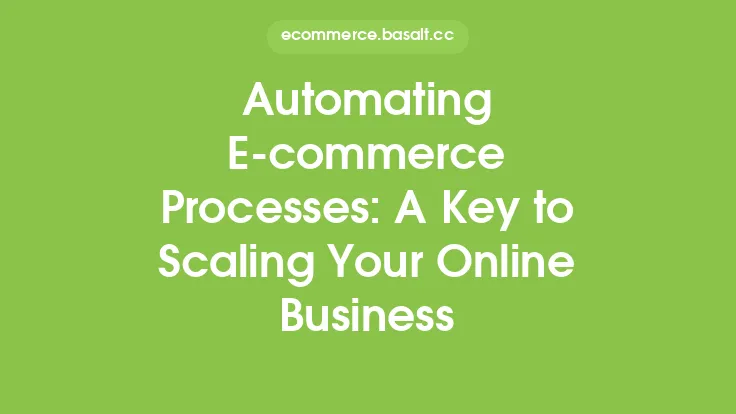The world of e-commerce is rapidly evolving, with new technologies and innovations emerging every day. One of the key areas of focus for e-commerce businesses is workflow optimization, which involves streamlining and automating repetitive tasks to improve efficiency and productivity. Automating repetitive tasks is a crucial aspect of e-commerce workflow optimization, as it enables businesses to free up resources, reduce errors, and improve customer satisfaction.
Understanding E-commerce Workflow Optimization
E-commerce workflow optimization refers to the process of analyzing, designing, and implementing workflows that are efficient, effective, and scalable. It involves identifying areas of the business where tasks are repetitive, time-consuming, or prone to errors, and implementing automation solutions to streamline these processes. The goal of workflow optimization is to create a seamless and efficient workflow that enables businesses to respond quickly to changing market conditions, customer needs, and competitive pressures.
Identifying Repetitive Tasks in E-commerce
The first step in automating repetitive tasks is to identify areas of the business where tasks are repetitive, time-consuming, or prone to errors. Some common examples of repetitive tasks in e-commerce include order processing, inventory management, shipping and fulfillment, customer service, and data entry. These tasks are often manual, labor-intensive, and prone to errors, which can lead to delays, lost sales, and dissatisfied customers. By identifying these tasks, businesses can begin to explore automation solutions that can help streamline and optimize their workflows.
Automation Tools and Technologies
There are a wide range of automation tools and technologies available to e-commerce businesses, including robotic process automation (RPA), machine learning (ML), and artificial intelligence (AI). These tools can be used to automate tasks such as data entry, order processing, and customer service, freeing up resources for more strategic and creative activities. Some popular automation tools and technologies used in e-commerce include Zapier, Automate.io, and Microsoft Power Automate. These tools enable businesses to integrate different applications and systems, automate workflows, and streamline processes.
Implementing Automation Solutions
Implementing automation solutions requires careful planning, design, and testing. Businesses must first identify the tasks they want to automate, and then select the automation tools and technologies that best meet their needs. They must also design and test their automation workflows, ensuring that they are efficient, effective, and scalable. Some best practices for implementing automation solutions include starting small, focusing on high-impact tasks, and monitoring and evaluating the effectiveness of automation workflows.
Benefits of Automating Repetitive Tasks
The benefits of automating repetitive tasks in e-commerce are numerous. Automation can help businesses improve efficiency and productivity, reduce errors and delays, and enhance customer satisfaction. It can also help businesses free up resources, reduce costs, and improve scalability. Some other benefits of automation include improved data accuracy, enhanced compliance, and increased competitiveness. By automating repetitive tasks, businesses can focus on more strategic and creative activities, such as product development, marketing, and customer engagement.
Common Challenges and Limitations
While automating repetitive tasks can bring numerous benefits, there are also common challenges and limitations that businesses must be aware of. Some of these challenges include the cost and complexity of automation tools and technologies, the need for ongoing maintenance and support, and the potential for job displacement. Businesses must also ensure that their automation workflows are designed and tested carefully, to avoid errors and delays. Some other challenges and limitations include the need for data quality and integrity, the potential for security breaches, and the importance of ongoing monitoring and evaluation.
Best Practices for E-commerce Workflow Optimization
To get the most out of automation, businesses must follow best practices for e-commerce workflow optimization. Some of these best practices include starting small, focusing on high-impact tasks, and monitoring and evaluating the effectiveness of automation workflows. Businesses must also ensure that their automation workflows are designed and tested carefully, to avoid errors and delays. Some other best practices include providing ongoing training and support, ensuring data quality and integrity, and continuously monitoring and evaluating the effectiveness of automation workflows.
Future of E-commerce Workflow Optimization
The future of e-commerce workflow optimization is exciting and rapidly evolving. New technologies and innovations are emerging every day, enabling businesses to automate and optimize their workflows in new and innovative ways. Some of the trends and technologies that are likely to shape the future of e-commerce workflow optimization include artificial intelligence (AI), machine learning (ML), and the Internet of Things (IoT). These technologies will enable businesses to automate and optimize their workflows in real-time, using data and analytics to drive decision-making and improve customer satisfaction.
Conclusion
Automating repetitive tasks is a crucial aspect of e-commerce workflow optimization, enabling businesses to improve efficiency and productivity, reduce errors and delays, and enhance customer satisfaction. By understanding e-commerce workflow optimization, identifying repetitive tasks, and implementing automation solutions, businesses can free up resources, reduce costs, and improve scalability. While there are common challenges and limitations to automation, businesses can overcome these by following best practices and staying up-to-date with the latest trends and technologies. As the world of e-commerce continues to evolve, automation will play an increasingly important role in enabling businesses to succeed and thrive in a rapidly changing market.




